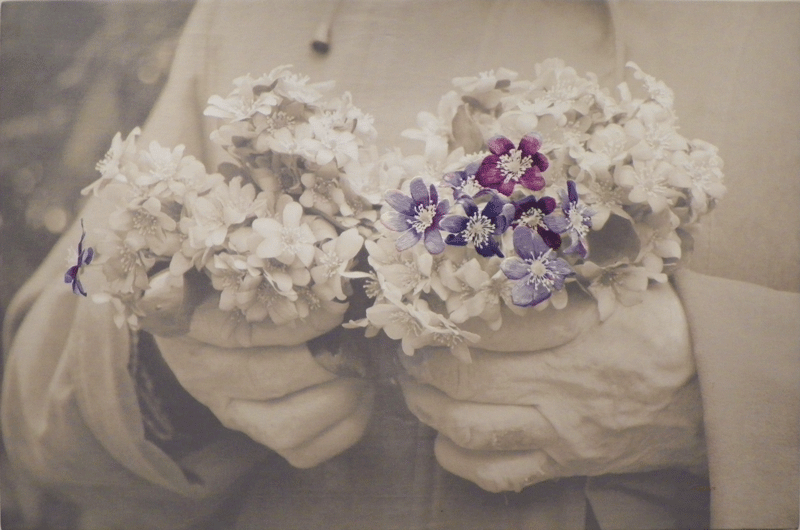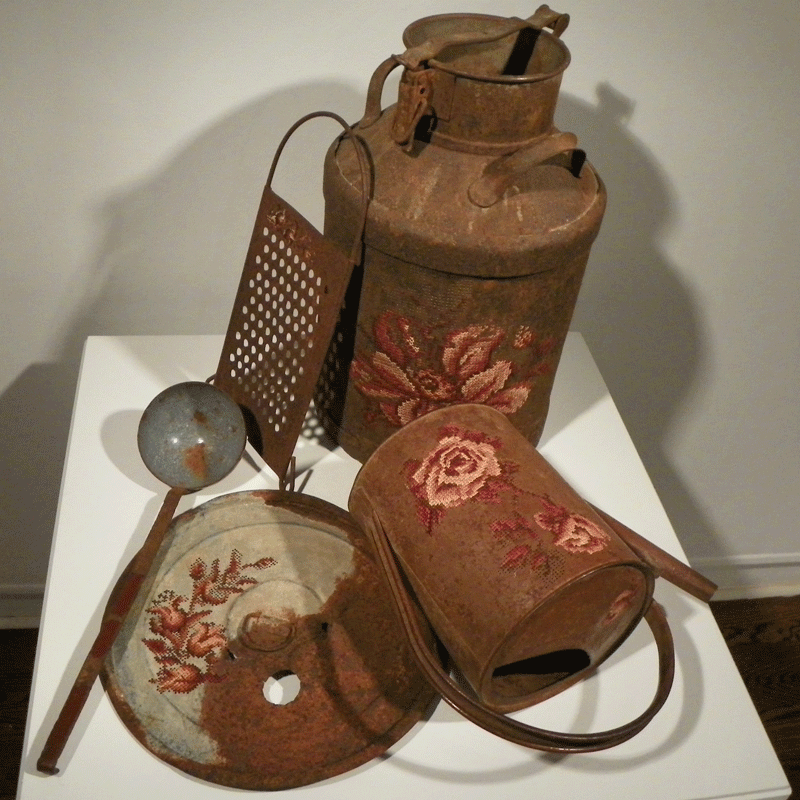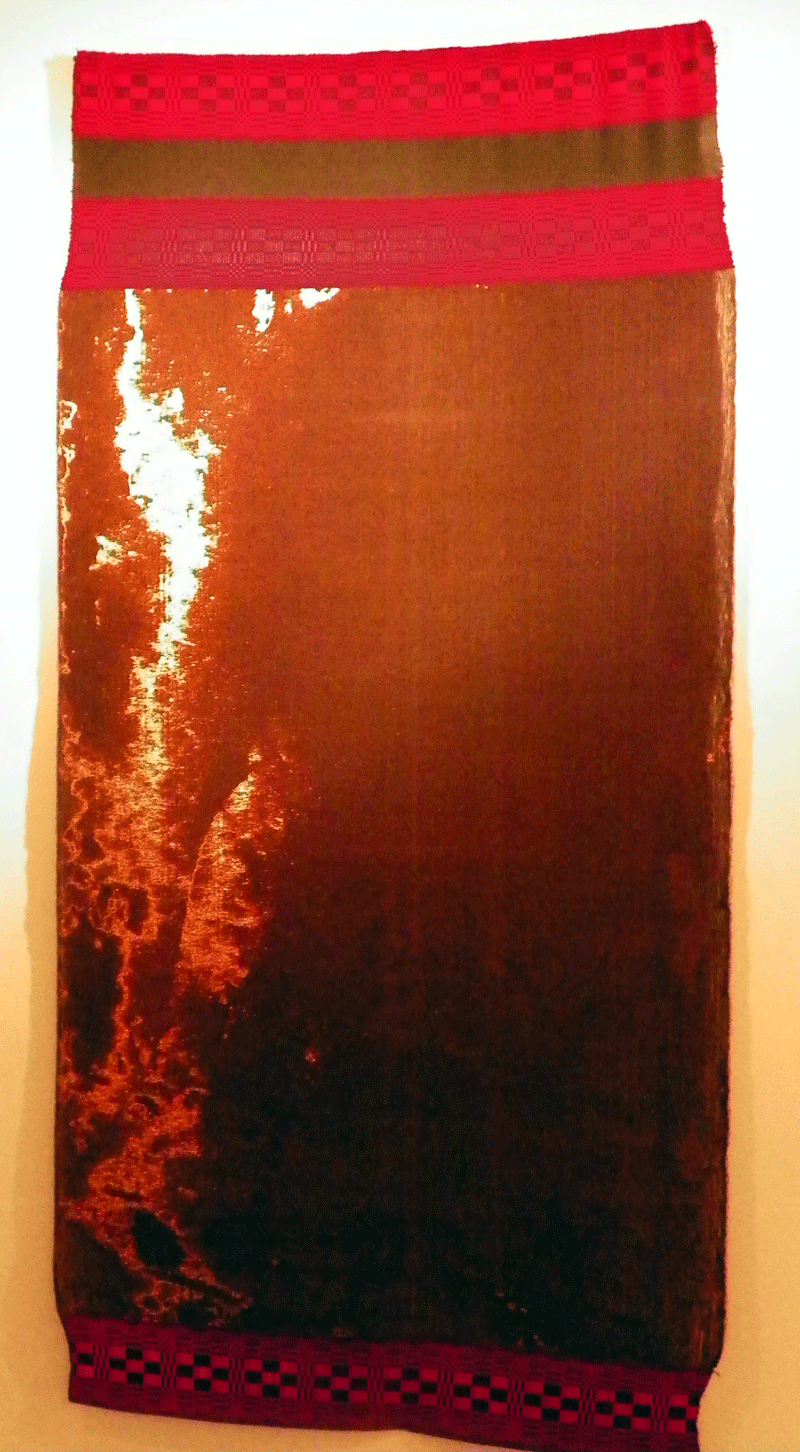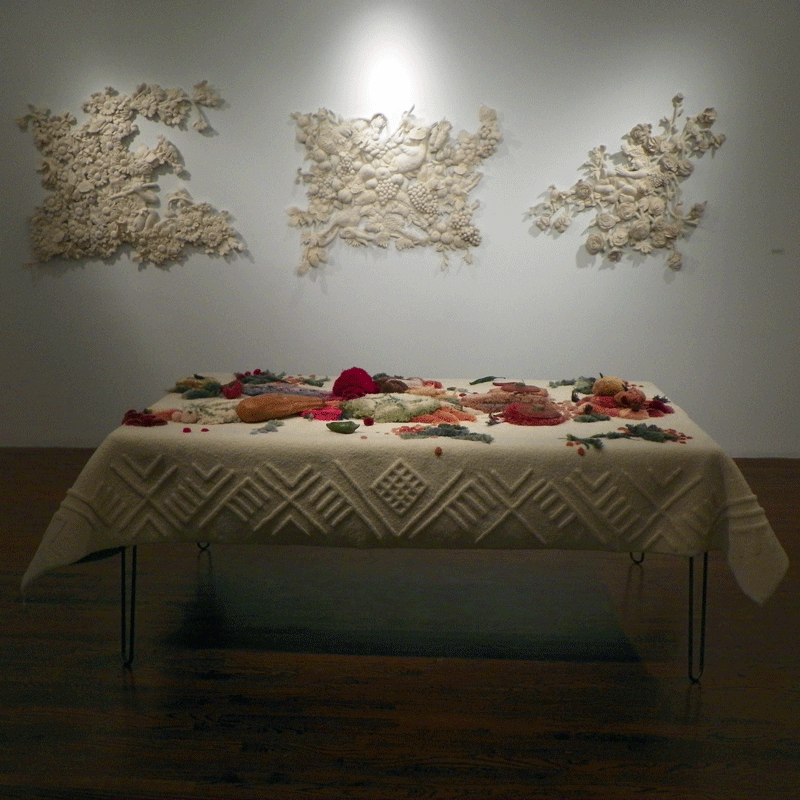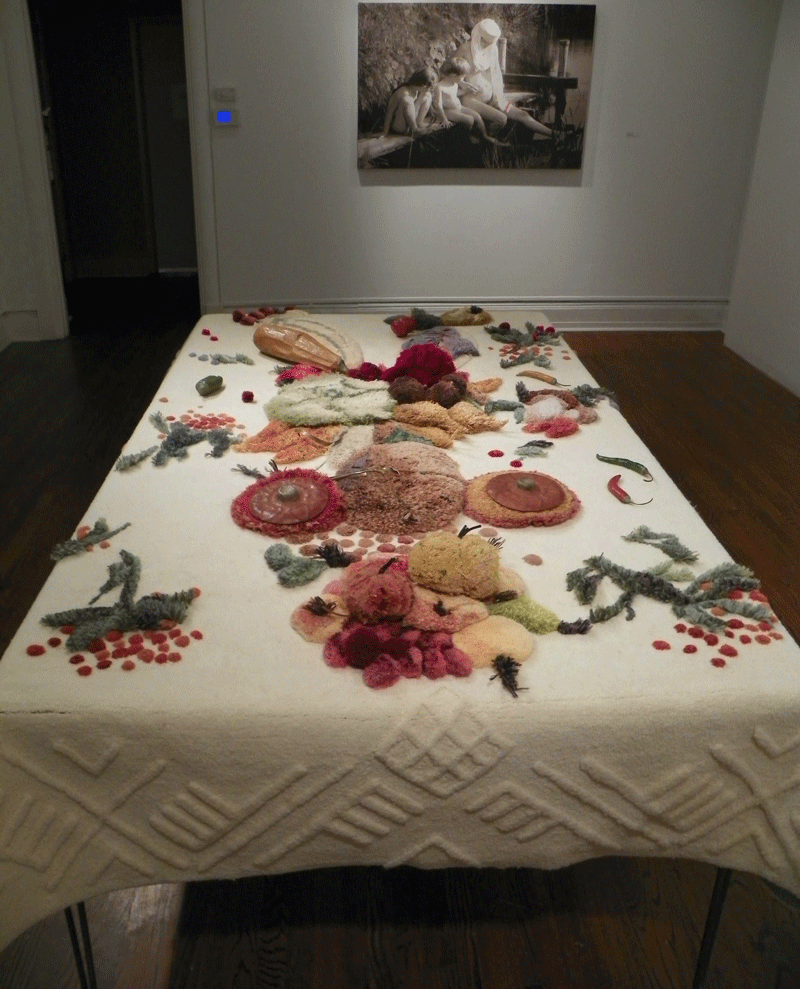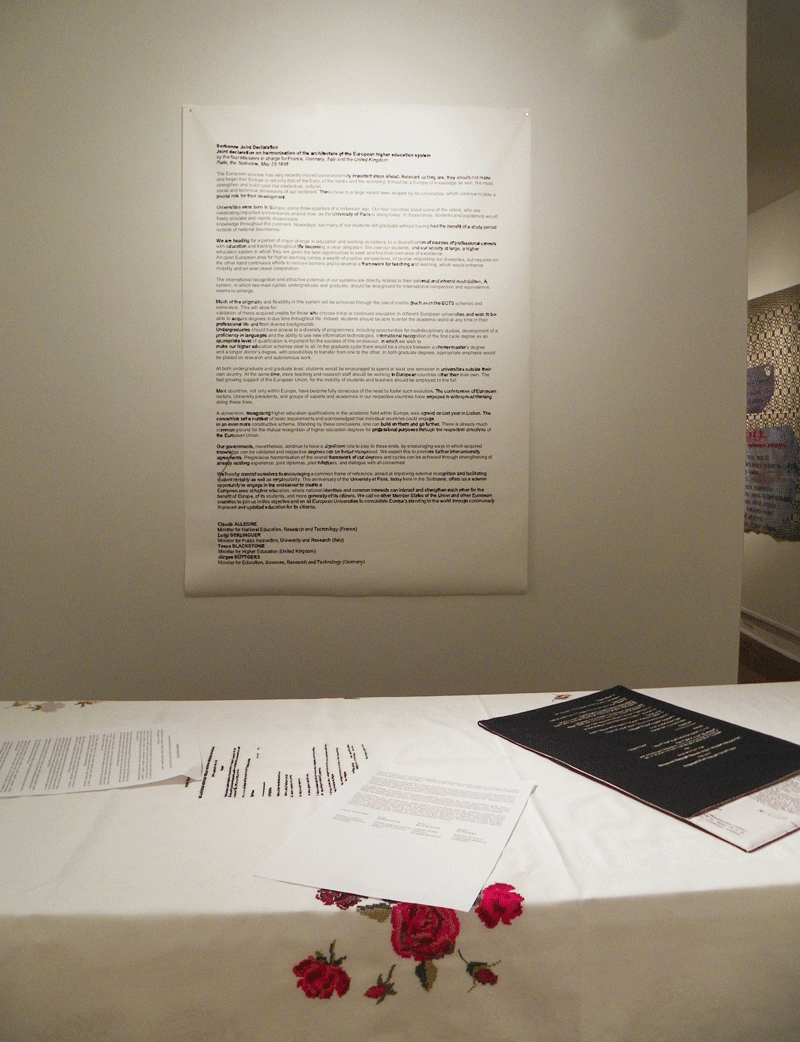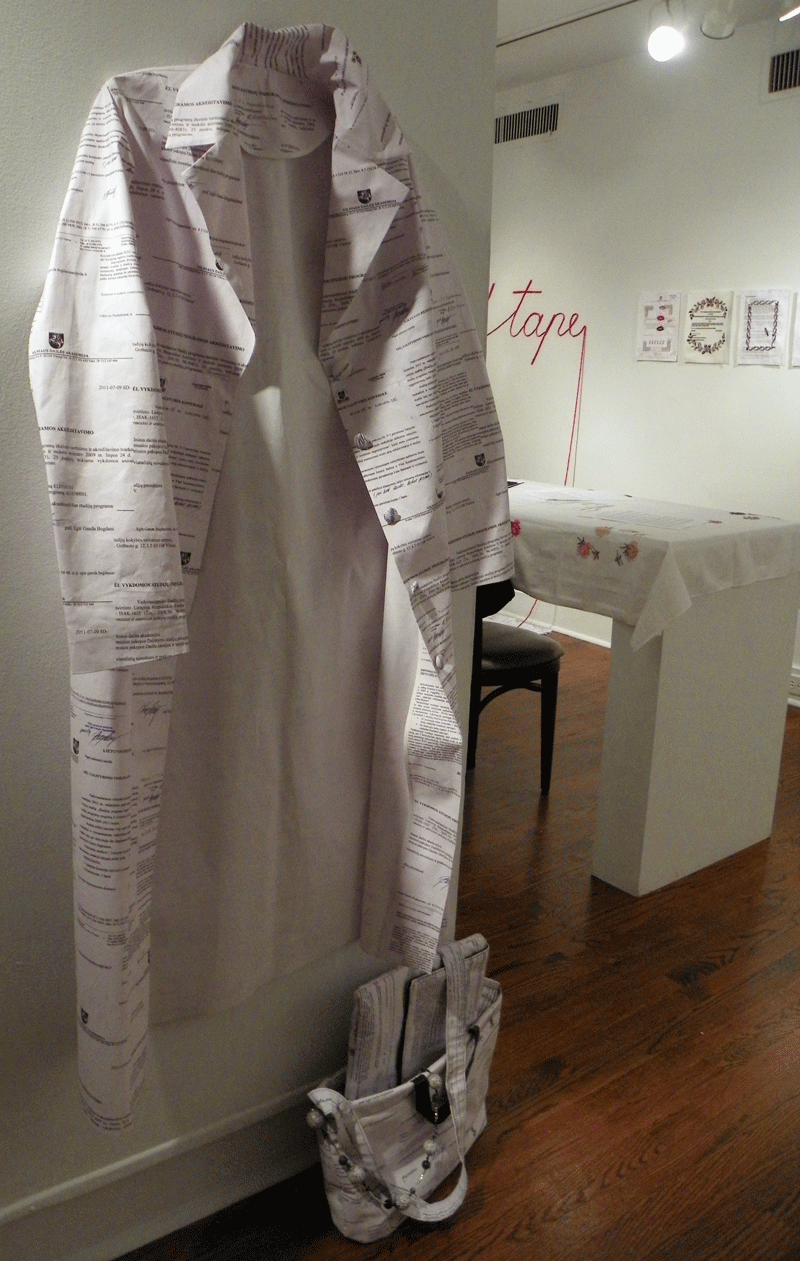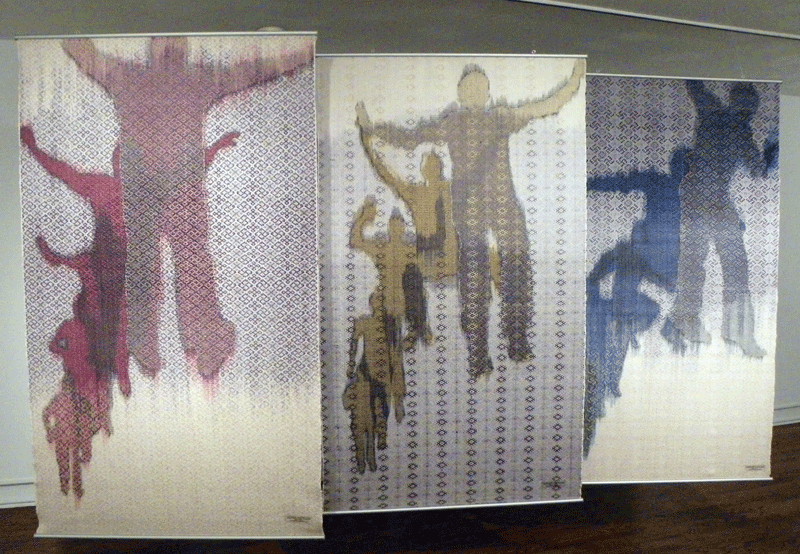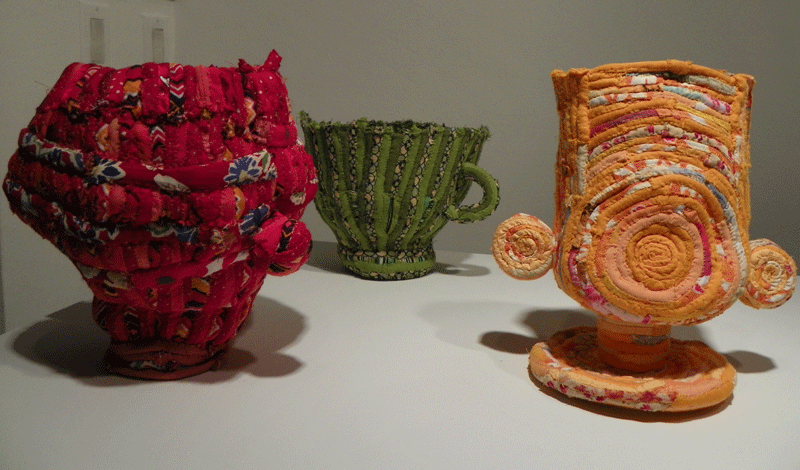Laima Oržekauskienė, Daily Life Series, 2010, “Ritual Washing Feet“, digital print, synthetic fiber, LTextile, Philadelphia Art Alliance
LTextile is a collection of contemporary textiles created by local and international artists associated with the Vilnius Academy of Art in Lithuania. Lithuania borders Latvia to the north, Belarus to the east and south, Poland to the south and the Baltic Sea is to the west.
The Vilnius Academy of Art (Lithuanian: Vilniaus dailės akademija, previously State Art Institute of Lithuania) in Vilnius, Lithuania, grants a variety of degrees in the arts. The academy was created as a separate entity in 1940; it had previously been part of Vilnius University. It was closed during the Nazi occupation of Lithuania, and re-opened in 1944. In 1951 it was organized into the following departments: painting (including frescos, mosaics, and theatrical design), graphics, sculpture, architecture, and ceramics and textiles. – Wikipedia
Lina Jonike, Flower Seller, 2008, digital print, embroidery, linen, silk, LTextile, Philadelphia Art Alliance
The LTextile art show mixes traditional fiber arts with high tech printing and weaving. Throughout the exhibition there is a wonderful exuberance, a liveness unrestrained yet with an underlying code like a secret message. Tapestry, weaving and crochet all rely on mathematical formulas to create a fabric and within the mathematics can be hidden a message like a secret code. DoN talked with Honorary Consul of the Republic of Lithuania to the Commonwealth of Pennsylvania Krista Bard about the mystery.
“So, when the Soviets took over after World War II, everything, all the schools, the businesses, was run by the State. Under very strict rules. You know? We talk about censure now but it’s almost incomprehensible to us in the U.S. culture because we have so much freedom, we’re not a perfect system yet, but, compared to the rest of the world our Democracy is fairly evolved. And we are moving in the right direction.
It’s only when you get into, when you see, an oppression, or you’ve lived through an oppressive situation, when you experience it, then you recognize it. When I went to Lithuania the first time in 1988 there was only one business that was privately owned, it was the first business that was privately owned. Everything else was run and dictated by the State.
In a sense, art survives. No matter what. And luckily the Soviets did not totally suppress art and culture but they put very strict rules in the subject matter. You were only allowed certain subject matter. But because of the symbolic nature of art itself, they found, Lithuanians and the other occupied countries, a way to express themselves none the less. And I think it actually strengthened their ability. Art, you can’t stop art. Anywhere. It’s not possible to do that. “
Severija Inčirauskaitė, Installation: Autumn Collection “Ladle, cover, grater, milk-can, watering can”, Found metal objects, cotton, cross-stitch, drilling”, LTextile, Philadelphia Art Alliance
“So, they kept creating. And they just developed another set of skills. There is one work of art in the middle gallery where at one point the Soviets did try to stop the language and stop religion. So religion was forbidden. What they did anyway was they used the Russian alphabet but they still wrote in the Lithuanian language.
They wouldn’t let themselves not find ways around it. There was a whole underground movement. Imagine? It was like Fahrenheit 451. Imagine if you were not allowed to speak English anymore. And all your books had to be hidden.
They wanted to suppress the language. Lithuanian and Latvian are the only remaining Baltic languages where we don’t understand each other. We’re talking about censoring the whole language. It was like, ‘OK. Now everything is going to be written in Russian. Or Chinese. That’s our official language.’ And suddenly you’re not allowed to speak your language anymore. There is no way you can suppress a language.”
Žydrė Ridulytė, Copper Cloth, 2009, weaving, semi-wool, wool, cotton, wire, LTextile, Philadelphia Art Alliance
“The denial. You know? There’s a term that says, ‘What you resist persists.’ You can’t suppress people. It doesn’t work. It actually tended to make people more patriotic and make them stronger in their desire to preserve their culture. And more clever about it.
The other thing the Soviets did is they relocated people. It is true that most people do not realize that the Soviets are considered to be as brutal as the Nazis were. They transported, Lithuania is three million people, they deported 300,000 people out of Lithuania. They were re-populating, sending people to work camps. And even if you didn’t go to a work camp all during the Soviet era they were physically moving people. We had no choice.
You and I could move to another city and go get a job somewhere else. But they would tell you where to go and they consciously wanted people to move to other places so they could systematically destroy the culture. And now in Lithuania there is a large population of Belarussians, of Poles, of Russians.
I was there when they sand-bagged the Parliament. It’s interesting the Lithuanian President was a musical historian. He’s a musician. He’s not a politician. It”s just people doing the right thing.”
Egle Ganda Bagdoniene, LTextile, Philadelphia Art Alliance
DoN asked Krista Bard how the Lithuanians overcame Soviet oppression? Was there other pressures going on?
“You can analyze it, historians do a far better job than I. My sense is it was a moment in history where forces came together. There’s only so far and so long that you can subjugate people. Now, of course, hindsight shows me that, but, at that time I never thought it would be possible. Things are constantly changing, there are opportunities. It’s very inspiring. It reminds me as I go through my days – what are the tunes that I’m not singing? What possibilities are there that I’m not seeing? What do I take for granted as it’s just the way it is? Well, that’s not true of anything. Everything can change. Soon Lithuania assumes the Presidency of the European Union. It’s an extraordinary moment. It really is.
Here in America we have such a vast country where we all speak the same language. And it’s all the same rules. We’re not forced like other countries to learn other languages or know our geography in quite the same way. In Lithuania a comparable thing would be like driving from Philadelphia to Pittsburgh and if you cross over into Ohio you’re in a totally different country that speaks another language. We would have to learn. But that’s what it’s like there.”
Egle Ganda Bagdoniene, LTextile, Philadelphia Art Alliance
Fiber arts are a major element of the Philadelphia art scene from Philadelphia University’s heritage of textile and science to the yarn bomber tags to fashion design and fine art. Fiber arts is taught in most of Philadelphia’s art schools. Philadelphians love finding one of Kathryn Pannepacker’s fence weavings creating a pop of art in unlikely locales. DoN wondered what the social life of young artists is like now in Lithuania? Is it like the university town vibe of Philly? Krista Bard said,
“Yes. It’s similar and there’s a strong emphasis on the whole center. The old town of Vilnius is an international historic site. Much like a good part of Philadelphia is historic and is on the national register. It’s unusual. There are a lot of comparisons: the emphasis on history, the emphasis on design. I think we think that we’re the only people in the world where X, Y & X are happening and yet the whole world is coming along together.
The internet has made communication and idea sharing very available. I will say this, though. I look at what’s happened in Lithuania, since I’ve been going there since 1988, seeing how quickly they adapted and adopted to a free market system. And to democracy. And even if you look at the art, all of the new ideas that are there, it’s like they were hungry for innovation. And they embraced it. There is an energy around. Even in the Soviet system there was still a high respect for art and culture.
Even Evaldas Stankevicius, Cultural Attaché to Lithuania, he’s in Washington and helped with this exhibition, had to serve in the Soviet armed forced. But because he had gone to art school he was given art duties. During his service he drew thirty-seven picture of Lenin.”
Egle Ganda Bagdoniene, LTextile, Philadelphia Art Alliance
DoN commented on the feminist aspect of the embroidered papers strewn across an embroidered table cloth. Pages of text embroidered with traditional images like flowers are lined up along the wall. Some of the text is even embroidered.
“What this is is from her dissertation. It was the bureaucracy, it was her way – she was over-burdoned by the bureaucracy – and how could she possibly make something beautiful into this? Is there any way that any of this could make any sense? She did. This is not hand done embroidery, it’s embroidered on a machine. She said, ‘These documents mean nothing to me. There has be something, some beauty, on them.’ She calls it Red Tape. Because this is the red tape she had to go through in her life. So her life is all woven up. Along with the coat and the bag. Your identity is wrapped up and she just wouldn’t tolerate having it be left alone. This was her statement to turn it into something pretty.” – Krista Bard
Egle Ganda Bagdoniene, LTextile, Philadelphia Art Alliance
Vladas Daškevičius, LTextile, Philadelphia Art Alliance
Philadelphia Art Alliance curator, Sarah Archer joined the conversation with some salient points.
“You know, Philadelphia Art Alliance is small and any time we get a chance to do something international we feel it’s a wonderful thing to bring to Center City and make it accessible to so many people. And also share that this is the tip of the ice-burg, it alerts people to media, design and contemporary craft and art that is not heavily on the radar.
Even walking through the show with the curators, the co-curators from Lithuania are in their forties and early fifties, I think, and they really ran to their embroidery because it’s something from their cultural archive. It’s something that their grandmothers did and that kind of happens all the time with artists. Ranging from Chile with Sheila Hicks who had a show at the ICA, to people like Sabrina Gschwandtner’s film quilts downstairs. Those are the kind of things that use feminist craft history and documents to creat non-comfortable, non-cozy artworks.”
Jurga Šarapova, Yellow Green Red, 2012, set of three bigger mugs, LTextile, Philadelphia Art Alliance
Sarah Archer continued, “There are lots of artists using these forms as almost an anonymous heritage that as women in the 21st Century, none of us were brought up to sew or we just do it for fun like knitting, time to unwind because we all work. So, it’s not the equivalent of being taught to sew as a child in 1910. Where your destiny is to be a Mom and darn socks. That’s totally different.
I still have all my grandmothers sewing and knitting things. My Mom was sort of a hipster in the 70s with embroidered jeans and I sort of love that line of activity, that sort of is keeping it alive in a way. But with a contemporary twist. Because it has, in our day and age, a totally different context. It means something else to embroider today. Duchamp wasn’t embroidering in 1911, there was not an art world equivalent to fiber art in that context.
This is a wonderful way to show people that it’s international. And every part of the world has textiles. We can’t live without them. We are sheathed in fiber. There’s a woman named Sonya Clark who said at a lecture, ‘If you think about it there are fibers touching you right now in places where it would be inappropriate to touch yourself in public.”
Discover the secret codes hidden in LTextile for yourself at the Philadelphia Art Alliance through August 18th, 2013.
LTextile is organized by Egle Ganda Bagdoniene, Vice-Rector at the Academy of Arts in Vilnius and Philadelphia Art Alliance Curator Sarah Archer.
Like Philadelphia Art Alliance on facebook
Like Vilnius Academy of Art on facebook
Written and photographed by DoN Brewer except where noted.
Like DoNArTNeWs Philadelphia Art News Blog on facebook
Follow the new DoNArTNeWs.com
Follow DoN on Twitter @DoNNieBeat58
DoNArTNeWS on Tumblr
@donniebeat on Instagram
Affiliate Marketing [disclosure page] Shop on-line and help support DoNArTNeWs


